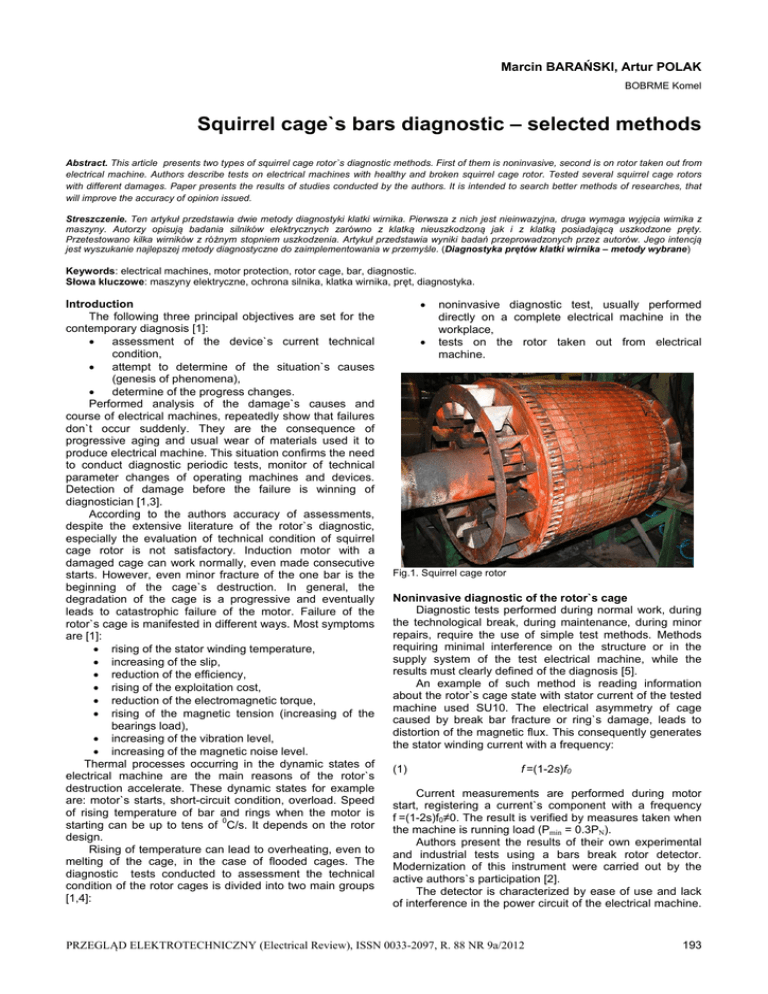Squirrel cage`s bars diagnostic – selected methods
advertisement

Marcin BARAŃSKI, Artur POLAK BOBRME Komel Squirrel cage`s bars diagnostic – selected methods Abstract. This article presents two types of squirrel cage rotor`s diagnostic methods. First of them is noninvasive, second is on rotor taken out from electrical machine. Authors describe tests on electrical machines with healthy and broken squirrel cage rotor. Tested several squirrel cage rotors with different damages. Paper presents the results of studies conducted by the authors. It is intended to search better methods of researches, that will improve the accuracy of opinion issued. Streszczenie. Ten artykuł przedstawia dwie metody diagnostyki klatki wirnika. Pierwsza z nich jest nieinwazyjna, druga wymaga wyjęcia wirnika z maszyny. Autorzy opisują badania silników elektrycznych zarówno z klatką nieuszkodzoną jak i z klatką posiadającą uszkodzone pręty. Przetestowano kilka wirników z różnym stopniem uszkodzenia. Artykuł przedstawia wyniki badań przeprowadzonych przez autorów. Jego intencją jest wyszukanie najlepszej metody diagnostyczne do zaimplementowania w przemyśle. (Diagnostyka prętów klatki wirnika – metody wybrane) Keywords: electrical machines, motor protection, rotor cage, bar, diagnostic. Słowa kluczowe: maszyny elektryczne, ochrona silnika, klatka wirnika, pręt, diagnostyka. Introduction The following three principal objectives are set for the contemporary diagnosis [1]: assessment of the device`s current technical condition, attempt to determine of the situation`s causes (genesis of phenomena), determine of the progress changes. Performed analysis of the damage`s causes and course of electrical machines, repeatedly show that failures don`t occur suddenly. They are the consequence of progressive aging and usual wear of materials used it to produce electrical machine. This situation confirms the need to conduct diagnostic periodic tests, monitor of technical parameter changes of operating machines and devices. Detection of damage before the failure is winning of diagnostician [1,3]. According to the authors accuracy of assessments, despite the extensive literature of the rotor`s diagnostic, especially the evaluation of technical condition of squirrel cage rotor is not satisfactory. Induction motor with a damaged cage can work normally, even made consecutive starts. However, even minor fracture of the one bar is the beginning of the cage`s destruction. In general, the degradation of the cage is a progressive and eventually leads to catastrophic failure of the motor. Failure of the rotor`s cage is manifested in different ways. Most symptoms are [1]: rising of the stator winding temperature, increasing of the slip, reduction of the efficiency, rising of the exploitation cost, reduction of the electromagnetic torque, rising of the magnetic tension (increasing of the bearings load), increasing of the vibration level, increasing of the magnetic noise level. Thermal processes occurring in the dynamic states of electrical machine are the main reasons of the rotor`s destruction accelerate. These dynamic states for example are: motor`s starts, short-circuit condition, overload. Speed of rising temperature of bar and rings when the motor is starting can be up to tens of 0C/s. It depends on the rotor design. Rising of temperature can lead to overheating, even to melting of the cage, in the case of flooded cages. The diagnostic tests conducted to assessment the technical condition of the rotor cages is divided into two main groups [1,4]: noninvasive diagnostic test, usually performed directly on a complete electrical machine in the workplace, tests on the rotor taken out from electrical machine. Fig.1. Squirrel cage rotor Noninvasive diagnostic of the rotor`s cage Diagnostic tests performed during normal work, during the technological break, during maintenance, during minor repairs, require the use of simple test methods. Methods requiring minimal interference on the structure or in the supply system of the test electrical machine, while the results must clearly defined of the diagnosis [5]. An example of such method is reading information about the rotor`s cage state with stator current of the tested machine used SU10. The electrical asymmetry of cage caused by break bar fracture or ring`s damage, leads to distortion of the magnetic flux. This consequently generates the stator winding current with a frequency: (1) f =(1-2s)f0 Current measurements are performed during motor start, registering a current`s component with a frequency f =(1-2s)f0≠0. The result is verified by measures taken when the machine is running load (Pmin = 0.3PN). Authors present the results of their own experimental and industrial tests using a bars break rotor detector. Modernization of this instrument were carried out by the active authors`s participation [2]. The detector is characterized by ease of use and lack of interference in the power circuit of the electrical machine. PRZEGLĄD ELEKTROTECHNICZNY (Electrical Review), ISSN 0033-2097, R. 88 NR 9a/2012 193 Ideally suited for use even by an unskilled worker. It is used to evaluate the induction motors in many industrial plants [2]. Below are presented the measurement`s results retrived from detector of cages. Fig.7. Work load with cage, which has broken three bars placed side together This cage`s indicator doesn`t require of interference on the electrical machine supply system. Measuring signal is current of stator in one phase. It is recorded by measuring probes on the power cable or cable in secondary winding of current transformer [2]. Fig.2. Start of motor with healthy cage Diagnostic cage of rotor taken out from motor During the repair, squirrel cage motor is dismantled. It`s needed to clearly determine the squirrel cage rotor winding is in good condition. Very good diagnostic tool for this, is break detector of rotor bars of induction motors with one cage. This device was designed and constructed by the authors. Technical assessment of the bar in the cage of rotor is performed by measurement each bar individually. Patent application No. P382389. Constructed of detector has a simple structure, is easy to use and provides an unequivocal interpretation of results. During the repair it`s needed to clearly determine the squirrel cage rotor winding is in good condition or rotor should be replaced by new. The cost of repair increase automatically. Commonly there are several breaks detectors of cage. They consist with two elements: induction exciter and sensor. Author`s detector links these two elements in one device. Fig.3. Work load with healthy cage Fig.4. Start of motor with cage, which has broken three bars arranged symmetrically Fig.8. Break detector of rotor bars of induction motors Fig.5. Work load with cage, which has broken three bars arranged symmetrically Fig.6. Start of motor with cage, which has broken three bars placed side together 194 Induction exciter is constructed with magnetic circuit which cover two adjacent teeth of the rotor. Exciter is applied to the rotor, that the slot was in the middle of the exciter core. Exciter winding is supply from AC source. Exciter magnetic flux is closed by the stator teeth and yoke. The current is induced by flux in the rotor`s bar. It raises it`s own magnetic field. Measuring winding is placed on the core of the detector and is short-circuited by the ammeter or to terminals is connected a voltmeter. If bar is good the ammeter A2 to shows a small current. If bar is broken the ammeter A2 to shows a higher current. If the supply voltage of exciter will have a constant value during measurements then it`s possible to compare the results of measurements for each bar. Basing on that measurements damaged bars would be selected. Preferred frequency of the supply voltage is 5 -10 Hz, because the impedance of the bar is dominated by the resistance, which is the parameter determined by cracks and breaks in the bar. PRZEGLĄD ELEKTROTECHNICZNY (Electrical Review), ISSN 0033-2097, R. 88 NR 9a/2012 single bar. That can prevent serious accidents and reduce the costs of possible repair [6]. In the article, authors share own experiences of the study of rotor cage. Present two methods of diagnostic tests also These results confirm the effectiveness of both methods. The first, noninvasive allows to determine the cage has damage. It is ideal for use in industrial plants, even by untrained personnel. It can be used in normal operation of the machine, which is its main advantage. The second method helps to determine exactly which bar is broken, but needs to draw the rotor of the machine. It is therefore useful during the repair machine in order to determine exactly where the damage occurs. a) I [mA] U [mV] 40 60 50 30 40 20 30 20 10 10 0 0 1 2 3 4 5 6 7 8 9 10 11 12 13 14 15 16 17 Bar number 0 0 1 2 3 4 5 6 7 8 9 10 11 12 13 14 15 16 17 Bar number b) c) Fig.9. Result of a healthy cage measurements. a) bars location, b) measurement of a current, c) measurement of a voltage a) I [mA] U [mV] 40 70 60 30 50 40 20 30 20 10 10 0 a) I [mA] 70 30 50 30 20 1 2 3 4 5 6 7 8 9 10 11 12 13 14 15 16 17 Bar number b) 0 4 5 6 7 8 9 10 11 12 13 14 15 16 17 Bar number 0 0 1 2 3 4 5 6 7 8 9 10 11 12 13 14 15 16 17 Bar number c) REFERENCES 10 0 3 Scientific work financed from the funds for science in 20112013 as research project No. N N510 594840 40 20 0 2 Fig.11. Result of a broken cage measurements, which has broken three bars placed side together a) bars location, b) measurement of a current, c) measurement of a voltage 60 10 1 b) U [mV] 40 0 0 1 2 3 4 5 6 7 8 9 10 11 12 13 14 15 16 17 Bar number c) Fig.10. Result of a broken cage measurements, which has broken three bars arranged symmetrically a) bars location, b) measurement of a current, c) measurement of a voltage In the article authors share their own experiences to the study of squirrel cage rotor induction motors. Present some methods of diagnostic tests to show their good and bed sides. It is intended to search better methods of researches, that will improve the accuracy of opinion issued. Summary Damage of the cage rotor doesn’t a common cause of failure of induction machines. However, it is generally accepted that in the medium and high power drives, where the number of starts during the year exceeds about 1000, damaging of the cages are the main cause of failure of the all drive. It is important to detect even small cracks in a [1] M. Barański, A. Polak, „Detektor do wykrywania przerw w prętach wirników jednoklatkowych”, Zeszyty Problemowe, Maszyny Elektryczne, Poland, 2011, [2] T. Janik, Ryszard Rut, „Sygnalizator uszkodzeń klatek silników indukcyjnych”, Zeszyty Problemowe, Maszyny Elektryczne, Poland, 1996, [3] T. Glinka, „Badania diagnostyczne maszyn elektrycznych w przemyśle”, Zeszyty Problemowe, Maszyny Elektryczne, Poland, 1993, [4] J. Przybysz, „Turbogeneratory, zagadnienia eksploatacyjne”, Instytut Energetyki, Warszawa, 2005, [5] M. Rad, „Diagnostyka wirnika maszyn indukcyjnych wykorzystaniem analizy falkowej i układów uczących się – rozprawa doktorska”, AGH, Kraków, 2009, [6] S. Szymaniec, „Diagnostyka stanu izolacji uzwojeń i stanu łożysk silników indukcyjnych klatkowych w warunkach przemysłowej eksploatacji”, Politechnika Opolska, Opole, 2006. Autorzy: dr inż. Artur Polak, BOBRME Komel, al. Roździeńskiego 188, 40-203 Katowice, E-mail: labor@komel.katowice.pl; mgr inż. Marcin Barański, BOBRME Komel, al. Roździeńskiego 188, 40-203 Katowice, E-mail: m.baranski@komel.katowice.pl. PRZEGLĄD ELEKTROTECHNICZNY (Electrical Review), ISSN 0033-2097, R. 88 NR 9a/2012 195

